
|
|
|
|
|
|
10,000-15,000 AD
The hypernova of Eta Carinae is affecting our region of the galaxy
Eta Carinae is among the largest, most volatile stars in our galaxy. Its temperature is so high that it is unable to hold onto its own gas, with constant streams being ejected from the surface. It first came to attention in 1843 when it flared to magnitude -0.8, becoming the second brightest star in the night sky.
It subsequently died down, before brightening again in the late 1990s. This fluctuation continues – with periodic flaring and dimming – until one day the inevitable happens. Unable to maintain its cohesion, Eta Carinae erupts into one of the deadliest known forces in nature: a hypernova.
For a brief period, this colossal explosion outshines the entire galaxy. It is bright enough to be visible during daytime on Earth, while at night, it is similar to the full moon.*
Of much greater concern, however, are the lethal jets of gamma radiation released by the dying star. These begin to shoot outward, at such high energies that even systems thousands of light years away are affected. As a result, numerous planets in our region of the galaxy undergo mass extinctions during this time.*
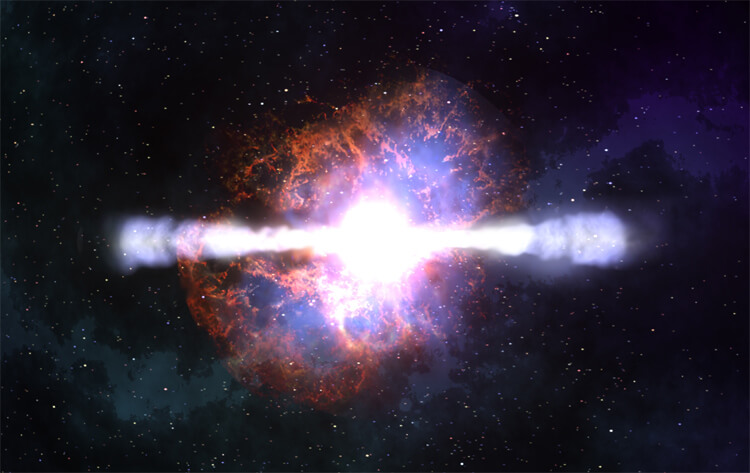
Credit: NASA/GSFC/Dana Berry
19,500 AD
Betelgeuse is colliding with a dusty wall
Betelgeuse is the nearest red supergiant star to Earth. It can be seen with the naked eye in the northern hemisphere winter night sky as the orange-red star above and to the left of Orion's famous three-star belt. Roughly 1,000 times the diameter and 100,000 times the brightness of the Sun, Betelgeuse is on its way to becoming a supernova, having already swelled in size and shed a significant fraction of its outer layers.
The star's winds are crashing against the surrounding interstellar medium, producing a curved "bow shock" as the star moves through space at 30 km/s. A series of broken, dusty arcs ahead of the star's direction of motion testify to a turbulent history of mass loss.
In the early 21st century, the Herschel Space Observatory found a mysterious wall-like structure in far-infrared. It was seen further away from the star, beyond the dusty arcs, its linear shape indicating that it was completely separate from and unrelated to Betelgeuse. It was, however, being illuminated by the supergiant. Astronomers of the time believed it was either a linear filament linked to the Galaxy's magnetic field, or the edge of a nearby interstellar cloud.
In 7000 AD, a collision occurs between the wall and the bow shock zone. This is followed by a collision between the wall and Betelgeuse itself, some 12,500 years later.*

Credit: ESA/Herschel/PACS/L. Decin et al
22,000 AD
The Chernobyl disaster site becomes fully safe
The Chernobyl explosion, which occurred in 1986, was the worst nuclear accident in history – affecting tens of thousands of square kilometres of land. Radiation at the centre of the former disaster zone has decayed to negligible levels by now.*
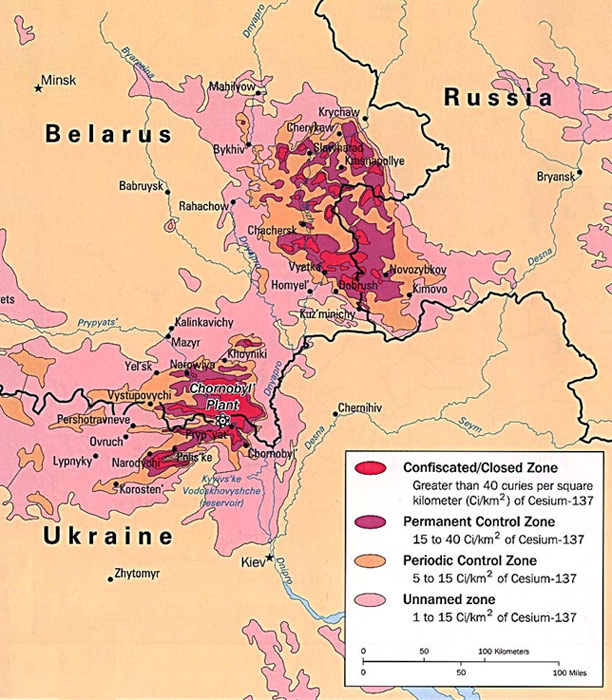
Chernobyl radiation hotspots. Credit: CIA
27,000 AD
The Arecibo message arrives at M13
In 1974, astronomers at the Arecibo Observatory in Puerto Rico beamed an interstellar radio message towards Messier 13 – a globular cluster in the constellation of Hercules. It became the most powerful broadcast ever deliberately sent into deep space, and formed part of the ceremonies held to mark a major upgrade of the radio telescope.
The broadcast was particularly powerful, because it used Arecibo's megawatt transmitter attached to its 305 metre antenna. The latter concentrated the transmitter energy by beaming it towards a very small patch of sky, potentially making it detectable to a receiving antenna operated by extraterrestrials many thousands of light years away.
The Arecibo message carried basic information about humanity and Earth. The binary transmission – designed to be easily decoded by intelligent aliens – contained a list of numbers, DNA elements, nucleotides, a double helix, the human form, planets of our Solar System, and a graphic representing the Arecibo radio telescope and indicating its diameter. In total, these 1,679 binary digits amounted to 210 bytes (0.21 KB) of data.
Messier 13 (M13) is one of about 160 globular clusters – dense, spherical collections of stars that resemble miniature galaxies – orbiting the Milky Way. Approximately 145 light years in diameter, M13 contains several hundred thousand stars. The cluster is located around 25,000 light years away, meaning a radio transmission sent from Earth in the late 20th century will arrive by the year 27000 AD.
By now, M13 is no longer in precisely the same location as in 1974 because of the cluster's orbit around the Milky Way centre. Even so, the proper motion of M13 is small, so the message can still arrive near the centre of the cluster.
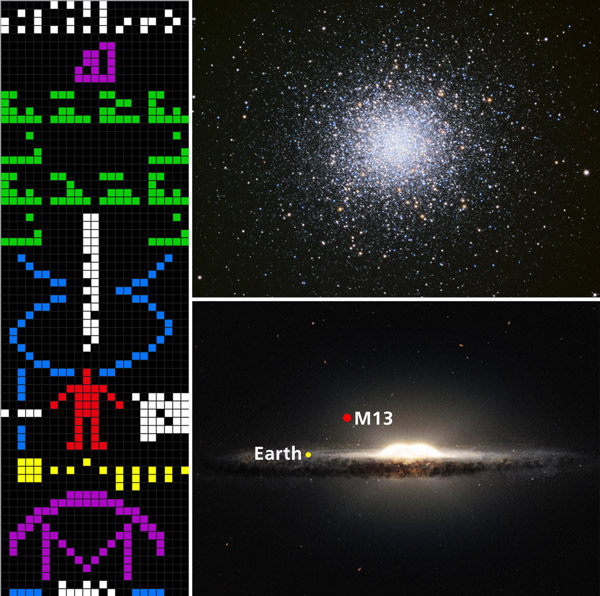
Credits: Arne Nordmann (norro), CC BY-SA 3.0 (Arecibo message);
Sid Leach/Adam Block/Mount Lemmon SkyCenter, CC BY-SA 4.0 (Messier 13);
ESO/NASA/JPL-Caltech/M. Kornmesser/R. Hurt, CC BY 4.0 (Milky Way);
all via Wikimedia Commons.
30,000 AD
The first wave of sub-light vessels has reached the galactic core
The Milky Way's core region is located 27-28,000 light years from Earth. At its very centre lies the largest black hole in the galaxy, a supermassive black hole known as Sagittarius A*.* Having travelled for many millennia, the first wave of sub-light spacecraft has now arrived in its vicinity.
These ships contain no physical human crew, being entirely computerised and automated. Numbering in the trillions, they have self-replicated along the way, using local stellar and planetary material gathered en route.* Systems encountered during this epic voyage have become seeded with computational substrates and saturated with artificial intelligence – individual planets and moons becoming like brain cells in a gigantic, artificial organism. It is almost as though the galaxy itself is waking up and achieving self-awareness.*
There is no competition or battle to claim ownership of the core. Wars, greed and archaic concepts of nationality have long since disappeared, with sentient beings now united under a common heritage.
In addition to the black hole are dense concentrations of ancient, metal-rich stars; in places separated by just a few light weeks or light days. These provide an enormous pool of resources for the approaching fleets.
Gamma radiation is very high in this region, making it harder for biological life to survive than in most other parts of the galaxy. Were an observer able to stand on a planet near the core, the sky above them would appear as a dazzling display of light and colour.
Having reached the galactic centre, the AI descendants of humanity begin to exploit the vast amounts of rotational energy from Sagittarius A* – by far the greatest source of power in all history, and a major milestone towards becoming a Type III civilisation on the Kardashev scale. Efforts are now underway to explore the far side of the galaxy and the mysteries that lie beyond. Dozens of globular clusters have also been reached by now.*
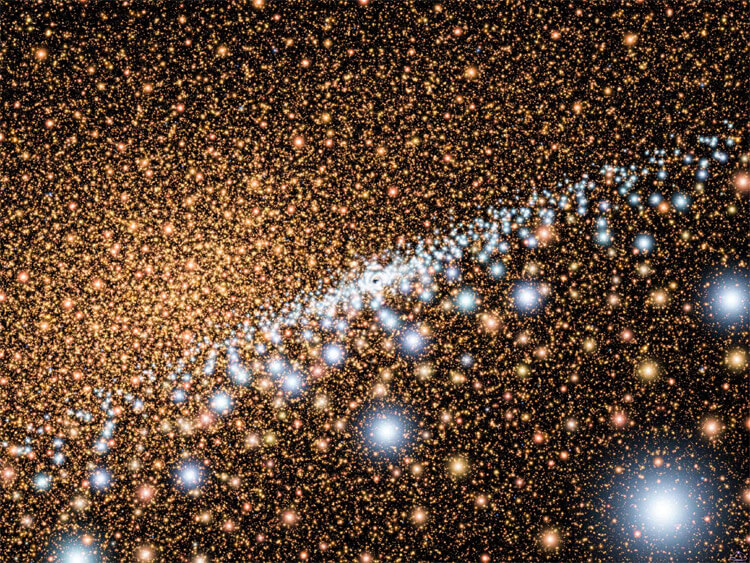
Credit: NASA, ESA and A. Schaller (for STScI)
35,000 AD
Ross 248 becomes the closest star to our Sun
Alpha Centauri was previously the closest star. Ross 248 is a red dwarf, with approximately 12% of the Sun's mass and 16% of the Sun's radius, but only 0.2% of its luminosity. However – it is also a "flare star", that periodically undergoes sudden, dramatic increases in brightness for a few minutes.
In 2010, Ross 248 was 10.3 light years from Earth, with a radial velocity of -81 km/s. By 35,000 AD, it is closer than Alpha Centauri. It reaches its closest point in 38,000 AD – moving to within 3.1 light years – before receding again, becoming further from the Sun than Alpha Centauri in 44,000 AD.
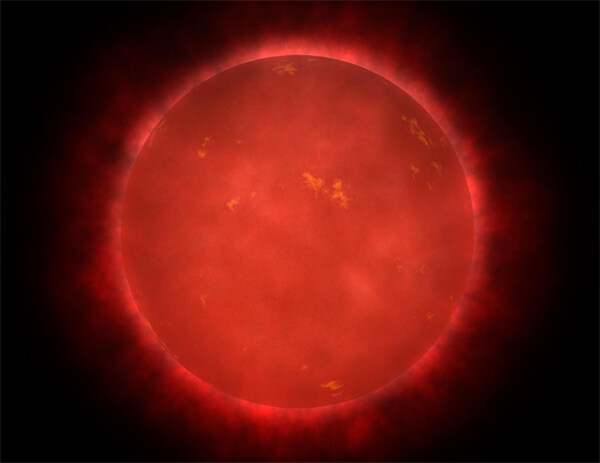
42,000 AD
Voyager 1 is passing near the red dwarf star, Gliese 445
Launched by NASA in 1977, the Voyager I space probe continues to drift through interstellar space. It is now passing near Gliese 445, an M-type main sequence star in the constellation of Camelopardalis, close to Polaris.* Its sister probe, Voyager 2, will reach Sirius in approximately 298,000 AD.
52,000 AD
Earth's day has been lengthened by one second
Circa 2000 AD, Earth rotated once every 24 hours. However, scientists discovered that this daily cycle had been slowing over the eons, due to gravitational interactions with the Moon. A day on Earth lasted only six hours during the early Hadean, for example, before the Moon had formed. A day lasted 21 hours during the Ediacaran Period around 600 million BC, with the Moon appearing larger in the sky compared to later periods.
Other phenomena besides the Moon affected Earth's rotation. Post-glacial rebound – the rise of land masses after the removal of the huge weight of ice sheets at the end of the Ice Age – changed the distribution of Earth's mass and its moment of inertia.
Abrupt events on shorter timescales had an effect too. The Indian Ocean earthquake of 2004, with a magnitude of 9.3, caused a shift in mass so great that it made the planet minutely "wobble" on its axis by 25 mm (1 in) and shortened the length of day by 2.68 microseconds. Even human-made structures had an influence on Earth's rotation. The volumes of water stored in China's Three Gorges Dam, for example, increased the length of Earth's day by 0.06 microseconds due to the shift in mass.*
Over geological periods, incremental changes in the relationship between the Earth and Moon continued into the future. By the year 52,000 AD, Earth's day has been lengthened by one second, relative to the year 2000.*

Tetrafluoromethane emissions from 2000 AD have been naturally reabsorbed
Tetrafluoromethane, also known as carbon tetrafluoride (CF4) is the longest-lived of all the greenhouse gases. Like other fluorocarbons, CF4 is very stable due to the strength of its carbon–fluorine bonds. Although structurally similar to chlorofluorocarbons (CFCs), it does not deplete the ozone layer. However, its heat-trapping potential is extremely high – roughly 11,200 times that of CO2 when measured on a per-molecule basis over a 500-year timescale.* Circa 2000 AD, the atmospheric concentration of CF4 was 80 parts per trillion. The main applications were as a low temperature refrigerant, in electronics microfabrication, as a plasma etchant (in combination with oxygen) and in neutron detectors.

69,163 AD
Transit of Mercury and Venus
A transit occurs when a planet moves between a star and an observer. Such events can be witnessed from Earth when Mercury or Venus pass in front of the Sun. Similarly, the Solar System's inner three planets – Mercury, Venus, and Earth – can be viewed passing in front of the Sun by an observer on Mars.
Transits are much rarer than eclipses of the Sun by the Moon. On average, 13 transits of Mercury take place each century. Transits of Venus are even rarer and occur in pairs separated by eight years, repeating every century or so, such as the events of 2004 and 2012, followed by 2117 and 2125.
Historically, transits provided astronomers with important mathematical and scientific information. For instance, the 1639 transit of Venus yielded estimates of both the size of Venus and the distance between the Sun and Earth, while the predicted transits of 1761 and 1769 further improved this accuracy via the use of the parallax principle. Scientists used a 2012 transit of Venus to refine their techniques for discovering exoplanets. Meanwhile, colonists on Mars witnessed a transit of Earth in 2084.
Even rarer still are transits involving two or more planets in the observer's field of view. A simultaneous transit of both Mercury and Venus (from the perspective of a viewer on Earth) last occurred on 22nd September 373,173 BC – during the Lower Palaeolithic, before "anatomically modern" humans had evolved. The next occurrence is 26th July 69,163 AD.* This double transit lasts for about 30 minutes. It does not occur again until 29th March 224,508 AD.
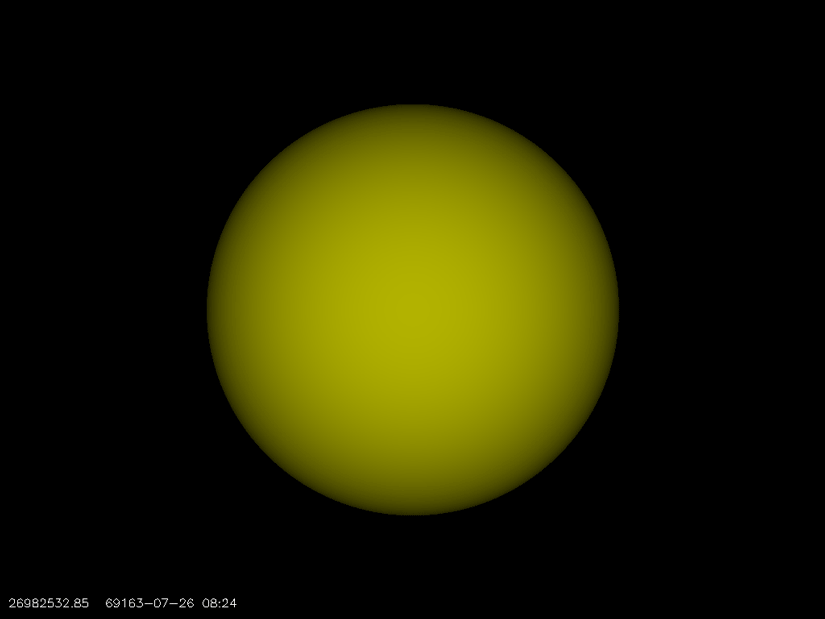
Credit: John Walker/Fourmilab Switzerland
82,684 AD
The return of comet c/2023 A3 (Tsuchinshan–ATLAS)
In January 2023, astronomers discovered comet C/2023 A3, named Tsuchinshan–ATLAS after the observatories in China and South Africa that independently reported its existence. This long-period comet – originating from the distant Oort Cloud – had one of the longest orbital periods known among famous comets, taking 80,660 years to complete its path around the Sun. The last time it passed through the inner Solar System coincided with the Stone Age, when early humans were creating primitive tools and beginning to decorate cave walls.
With a highly elliptical orbit, C/2023 A3 reached its closest approach to the Sun (perihelion) in September 2024. It became visible to the naked eye, peaking in brightness in early October. On 12th October 2024, it made its closest approach to Earth at 71 million km (44 million miles). Skywatchers marvelled at the object and its tail, which briefly outshone even Jupiter at magnitude -2.5, before gradually fading by the end of the month.
In 82,684 AD – after traversing the Solar System's outer reaches for nearly 81,000 years – the comet returns once again.* Though millennia of technological advances have passed, the same comet that intrigued humans in the 21st century now offers a rare glimpse into the Solar System's ancient past, a cosmic time capsule that links vastly different eras of human civilisation.
100,000 AD
The red hypergiant star, VY Canis Majoris, has exploded by now, producing one of the largest supernovas the galaxy has ever seen
VY Canis Majoris, at between 1800 and 2100 times bigger than our Sun (8.4–9.8 au, 2.7 billion km or 1.7 billion miles in radius), is the largest known star in the Milky Way, and also one of the brightest known. It is located around 4,900 light years from Earth, in the constellation Canis Major. It was discovered to be very unstable, throwing off much of its mass into the surrounding nebula. By 100,000 it has finally exploded, creating a supernova bright enough to be seen during daylight hours on Earth.*
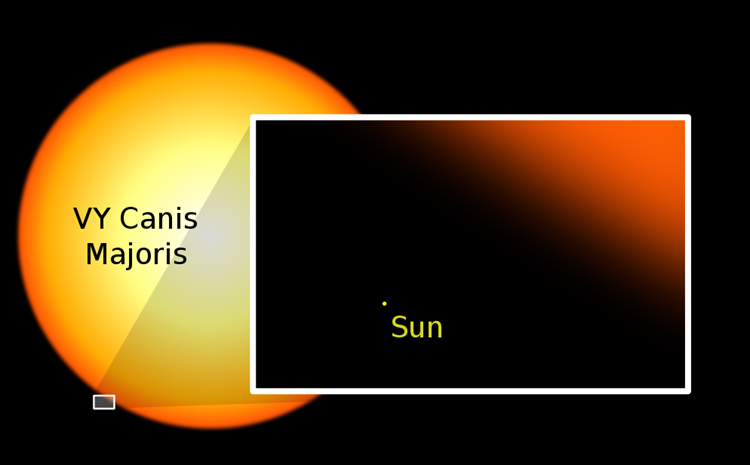
Betelgeuse is a supernova
Arguably the most famous of the red supergiants, Betelgeuse forms the top left part of the Orion constellation, 530 light years from Earth. With an estimated age of only 10 million years, it evolved rapidly due to its high mass. Having been ejected from its birthplace in the Orion OB1 stellar association – a group of several dozen hot giants – this runaway star was observed crashing through the interstellar medium at a supersonic speed of 30 km/s, creating a bow shock over four light-years wide. By 100,000 AD, it has erupted into a type II supernova, bright enough to be seen during daylight hours on Earth.*

By Henrykus (Celestia) [GPL (http://www.gnu.org/licenses/gpl.html)], via Wikimedia Commons
200,000 AD
Constellations visible from Earth have been rendered unrecognisable
Proper motion – the continuous movement of celestial bodies due to changing orbits or the remaining effects of the Big Bang – has radically changed the view of the night sky from Earth. Stars naturally move at different velocities, depending on the manner in which a star formed from its original dust cloud. By 50,000 AD, constellations were beginning to be twisted and bent into new shapes and by 200,000 AD have become completely unrecognisable.* This includes once famous groups of stars like the Big Dipper, Orion, Ursa Major, Perseus and Gemini. As a result of changes in Earth's axial orientation, Gamma Cephei, Iota Cephei and Vega have taken the position of the North Star.

298,000 AD
Voyager 2 is approaching Sirius
Voyager 2 was an unmanned space probe launched in 1977 to investigate the outer planets of the solar system. Identical in form and function with its sister craft, Voyager 1, it was launched on a slower, more curved trajectory that allowed it to be kept in the plane of the ecliptic. This enabled it to be sent on to Uranus and Neptune by means of utilising gravity assists during its fly-by of Saturn in 1981 and of Uranus in 1986.
By 2010, Voyager 2 was around 92 AU (13.75 billion km, 8.5 billion miles, or 0.001443 ly) from the Sun, deep in the scattered disc, and traveling outward at roughly 3.26 AU per year.
The probe survives for thousands of years in the emptiness of interstellar space. It eventually passes by Sirius, having covered a distance of over 25 trillion miles.* Sirius is the brightest star in the sky when viewed from Earth.
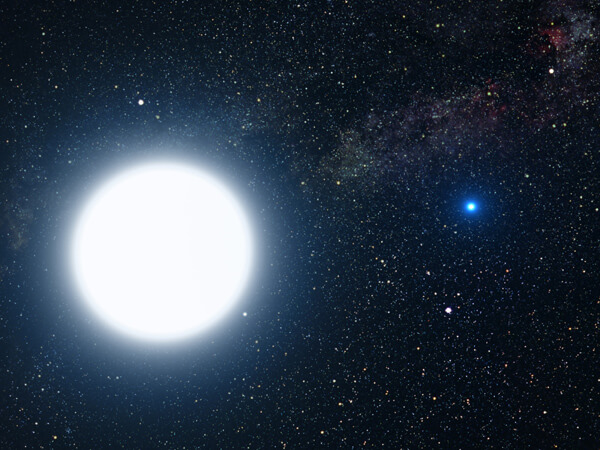
Credit: NASA
900,000 AD
The next Yellowstone super-eruption
During the early Miocene, around 16 million BC, volcanism began in the U.S. states of Nevada and Oregon. Over subsequent geological ages, this activity moved gradually eastwards – in the opposite direction of the shifting continental plate – to neighbouring Idaho and eventually Wyoming.
Between 10 and two million BC, major forces reshaped the entire region and pushed the land up by several thousand feet, creating new mountain ranges and large faults. During the first half of this period, major eruptions occurred with relative regularity, some ranking among the Neogene's largest.
As the volcanism progressed northeast, leaving several calderas in its wake, vast quantities of molten rock accumulated in a region that would later come to be known as Yellowstone. This would be the site of the next caldera. Driven by enormous, pent-up pressures below ground, a first super-eruption took place here around 2.1 million BC. The explosion produced nearly 2,500 cubic kilometres of debris, about 10,000 times greater than Mount St Helens in 1980, raining hot ash across a vast area of the United States. Two subsequent events occurred on a smaller scale (but still huge, compared to regular volcanoes) in 1.3 million BC and then 640,000 BC. An additional caldera-forming event produced the small area later filled by the West Thumb of Yellowstone Lake in approximately 170,000 BC.
As humans gained a scientific knowledge of geology, concerns grew of another super-eruption in the Yellowstone hotspot. A rising trend of larger and larger eruptions had been identified from 10 million years BC through to the present. Alongside this, earthquakes in the national park had become more frequent between the 1970s and 2010s. Observations of geological activity in the region – such as tremors, gas emissions and ground deformation – stoked frequent fears of the next major event being "overdue". Supervolcanoes became featured in movies depicting apocalyptic scenarios for humanity.
However, a study in 2020 revealed what appeared to be declining activity in the caldera chain, when viewed on a geological timescale. Deposits found across tens of thousands of square kilometres – previously thought to belong to multiple, smaller eruptions – in fact comprised material from two gigantic super-eruptions. These had occurred at 9.0 and 8.7 million BC, respectively, the latter being the largest known event to ever take place in the region, with an estimated 2,800 cubic kilometres of debris, even more than the eruption of 2.1 million BC.*
The newly revised data suggested that super-eruptions had reduced in both frequency and intensity since the Miocene epoch. While uncertainties remained in terms of forecasting, another major event did not seem likely until the year 900,000 AD. Furthermore, this prediction did not take into account the potential future technologies developed by humanity (or its descendants) by then, such as the ability to control tectonic plates and the underlying mantle.
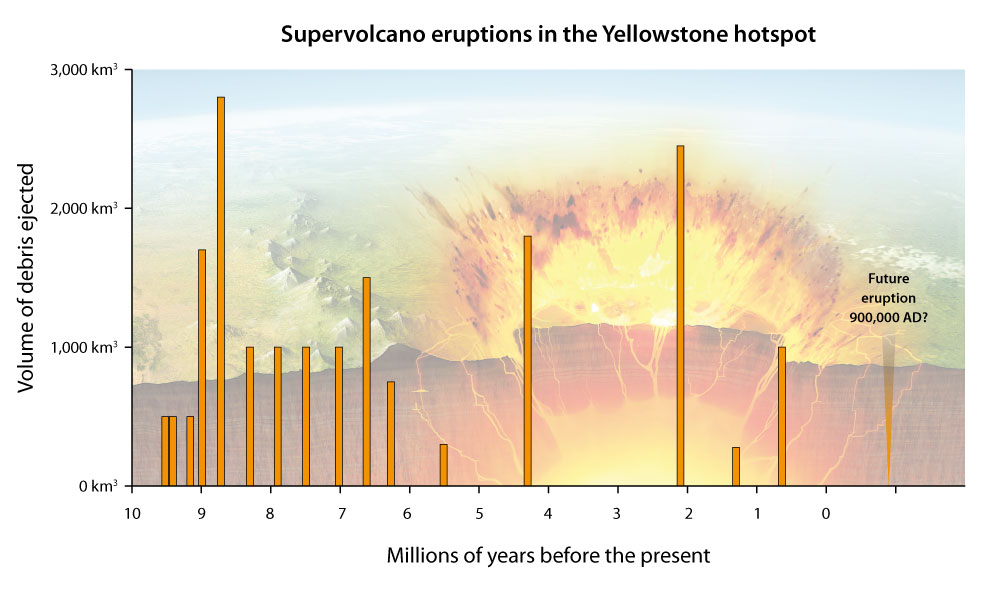
Background image: Mark Garlick / Alamy.com
« 9999 |
⇡ Back to top ⇡ |
1000000 » |
If you enjoy our content, please consider sharing it:
References
1 Eta Carinae, Wikipedia.org:
http://en.wikipedia.org/wiki/Eta_Carinae
Accessed 14th November 2009.
2 It is unlikely that Earth would be affected. Even if the gamma ray jets point in our direction, the solar system will likely be protected by a Dyson shell (or similar giant structure) by then. Less developed colonies in other star systems might not be so fortunate, however.
3 "...the outermost arc will collide with the bar in just 5000 years, with the red supergiant star itself hitting the bar roughly 12,500 years later."
See Betelgeuse Braces for a Collision: Red Supergiant Star to Crash Into Dusty 'Wall', Science Daily:
http://www.sciencedaily.com/releases/2013/01/130122105615.htm
Accessed 24th January 2013.
4 "There is a 17 mile Exclusion Zone around Chernobyl where officially nobody is allowed to live, but people do. These "resettlers" are elderly people who lived in the region prior to the disaster. Today there are approximately 10,000 people between the ages of 60 and 90 living within the Zone around Chernobyl. Younger families are allowed to visit, but only for brief periods of time.
"Eventually the land could be utilized for some sort of industrial purpose that would involve concrete sites. But estimates range from 60–200 years before this would be allowed. Farming or any other type of agricultural industry would be dangerous and completely inappropriate for at least 200 years. It will be at least two centuries before there is any chance the situation can change within the 1.5-mile Exclusion Zone. As for the #4 reactor where the meltdown occurred, we estimate it will be 20,000 years before the real estate is fully safe."
See Disasters:
Wasted Lives, Valuable Lessons, Randall Bell
http://www.amazon.co.uk/Disasters-Wasted-Lives-Valuable-Lessons/dp/1930819439/ref=sr_1_2?s=books&ie=...
Accessed 30th July 2010.
5 Galactic Center, Wikipedia:
http://en.wikipedia.org/wiki/Galactic_Center
Accessed 12th February 2011.
6 von Neumann Probe, daviddarling.info:
http://www.daviddarling.info/encyclopedia/V/vonNeumannprobe.html
Accessed 12th February 2011.
7 "We will ultimately saturate all of the matter and energy in our
area of the universe with our intelligence... All of this dumb matter
and energy around us will wake up and become sublimely intelligent. Then
it will spread out to the whole universe at the fastest speed information
can flow. And one could make an argument that it’s not going to
take an infinitely long time because there may be other ways to get to
other parts of the universe through shortcuts like wormholes, which physics
has postulated. Eventually the whole universe will, essentially, wake
up."
The technology of universal intelligence, KurzweilAI:
http://www.kurzweilai.net/the-technology-of-universal-intelligence
Accessed 12th February 2011.
8 Globular Clusters, Atlas of the Universe:
http://www.atlasoftheuniverse.com/globular.html
Accessed 12th February 2011.
9 Voyager Humanity's Farthest Journey, SpaceRip:
http://www.youtube.com/watch?v=lTEK7HhFLMw
Accessed 3rd May 2011.
10 Earth's rotation, Wikipedia:
https://en.wikipedia.org/wiki/Earth%27s_rotation
Accessed 15th April 2021.
11 How Long Until The Moon Slows The Earth To A 25 Hour Day?, Forbes:
https://www.forbes.com/sites/jillianscudder/2017/01/28
Accessed 15th April 2021.
12 Greenhouse Gas – Global Warming Potential, Wikipedia:
https://en.wikipedia.org/wiki/Greenhouse_gas#Global_warming_potential
Accessed 28th August 2014.
13 When Planets Transit, NASA:
https://www.nasa.gov/feature/when-planets-transit
Accessed 1st May 2022.
14 "Preliminary analysis of its trajectory suggests Comet A3 completes an orbit around the sun every 80,660 years."
See Will Comet A3 and Comet S1 become visible in October skies?, EarthSky:
https://earthsky.org/space/comet-c-2023-a3-sep-oct-2024-tsuchinshan-atlas/
Accessed 8th October 2024.
15 Crazy Image Shows How Tiny Earth Is Compared To Our Sun, Business Insider:
http://uk.businessinsider.com/earth-size-compared-to-sun-graphic-2015-1
Accessed 29th December 2017.
16 Betelgeuse is smaller and closer than previously thought, Future Timeline Blog:
https://www.futuretimeline.net/blog/2020/10/23-betelgeuse-25-percent-smaller-closer-future-timeline.htm
Accessed 23rd October 2020.
17 The Unfixed Stars, National Research Council Canada [2012].
18 Voyager – Interstellar Mission, Nasa.gov:
http://voyager.jpl.nasa.gov/mission/interstellar.html
Accessed 25th May 2009.
19 Yellowstone Had Nearly 300 Earthquakes In May—But It's No Biggie, Forbes:
https://www.forbes.com/sites/suzannerowankelleher/2020/06/05/yellowstone-had-nearly-300-earthquakes-in-may-but-no-biggie/
Accessed 19th June 2020.






